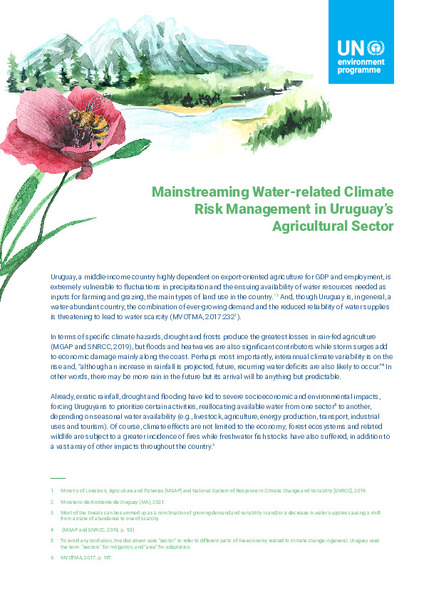| dc.contributor | Ecosystems Division | en_US |
| dc.contributor.author | United Nations Environment Programme | en_US |
| dc.coverage.spatial | Uruguay | en_US |
| dc.date.accessioned | 2022-11-04T08:39:50Z | |
| dc.date.available | 2022-11-04T08:39:50Z | |
| dc.date.issued | 2022-11 | |
| dc.identifier.uri | https://wedocs.unep.org/20.500.11822/41110 | |
| dc.description | Uruguay, a middle-income country highly dependent on export-oriented agriculture for GDP and employment, is extremely vulnerable to fluctuations in precipitation and the ensuing availability of water resources needed as inputs for farming and grazing, the main types of land use in the country. In terms of specific climate hazards, drought and frosts produce the greatest losses in rain-fed agriculture (MGAP and SNRCC, 2019), but floods and heatwaves are also significant contributors while storm surges add to economic damage mainly along the coast. Reacting to these trends, the government of Uruguay has begun to formulate sector- and area-specific lines of action in its national planning strategy for adaptation to manage water-related climate risks. | en_US |
| dc.format | Text | en_US |
| dc.language | English | en_US |
| dc.rights | Public | en_US |
| dc.subject | climate change adaptation | en_US |
| dc.subject | water management | en_US |
| dc.subject | agriculture | en_US |
| dc.subject | case study | en_US |
| dc.subject | Uruguay | en_US |
| dc.title | Mainstreaming Water-related Climate Risk Management in Uruguay’s Agricultural Sector | en_US |
| wd.identifier.sdg | SDG 6 - Clean Water and Sanitation | en_US |
| wd.identifier.sdg | SDG 13 - Climate Action | en_US |
| wd.topics | Climate Action | en_US |
| wd.identifier.pagesnumber | 5 p. | en_US |


